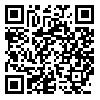
 , Nima Rezazadeh *
, Nima Rezazadeh * 
 2, Abdollah Moossavi1
2, Abdollah Moossavi1 
 , Hojjat Allah Haghgoo3
, Hojjat Allah Haghgoo3 
 , Sedigheh Farokhi Moghadam3
, Sedigheh Farokhi Moghadam3 
 , Ebrahim Pishyareh3
, Ebrahim Pishyareh3 
 , Enayatollah Bakhshi4
, Enayatollah Bakhshi4 
 , Reza Rostami5
, Reza Rostami5 
 , Vahid Sadeghi6
, Vahid Sadeghi6 
 , Yousef Khodabandelou5
, Yousef Khodabandelou5 

2- Department of Audiology, University of Social Welfare and Rehabilitation Sciences, Tehran, Iran.
3- Department of Occupational Therapy, University of Social Welfare and Rehabilitation Sciences, Tehran, Iran.
4- Department of Statistics, University of Social Welfare and Rehabilitation Sciences, Tehran, Iran.
5- Department of Psychology, School of Behavioral Sciences and Mental Health, Tehran University of Medical Sciences, Tehran, Iran.
6- Department of Psychology, Faculty of Education and Psychology, Shahid Beheshti University, Tehran, Iran.
The vestibular system is important for the development of normal movement reactions, motion tolerance, and motor control for postural alignment, balance, and vision. A vestibular system that is damaged by disease or injury in childhood can have a major impact on a child’s development. In addition, the emergence of vestibular lesions may also lead to cognitive deficits, including attention deficit. Despite the advances in testing and documentation of vestibular deficits in children, the vestibular problems continue to be an overlooked entity. Many children do not receive treatment that could significantly improve function and address the developmental delays caused by vestibular disorders.
Vestibular rehabilitation therapy (VRT) has been defined as an effective modality for most individuals with disorders of the vestibular or central balance system disorders. The basis for the success of VRT is the use of existing neural mechanisms in the human brain for adaptation, plasticity, and compensation. The vestibular system cannot be considered as a separate entity
ignoring other balance subsystems. Hence, a modified VRT program, named pediatric balance therapy with special modifications in exercises, was developed for children with vestibular disorders, in accordance to the whole balance system.
Received: 2015/07/14 | Accepted: 2015/11/15 | Published: 2016/03/1
| Rights and permissions | |
 |
This work is licensed under a Creative Commons Attribution-NonCommercial 4.0 International License. |


